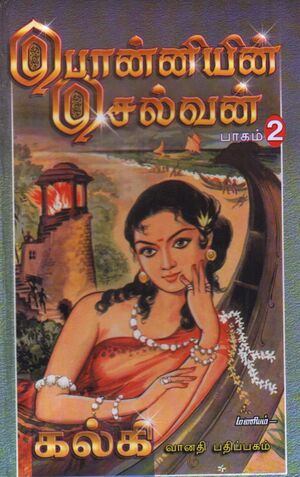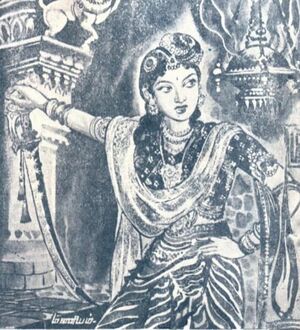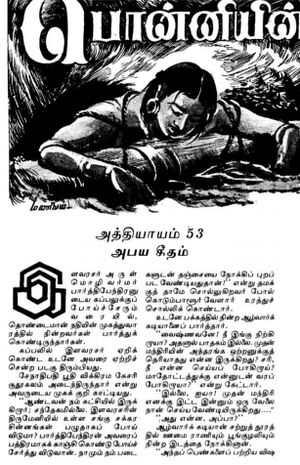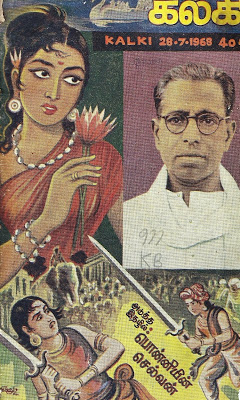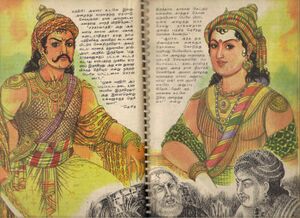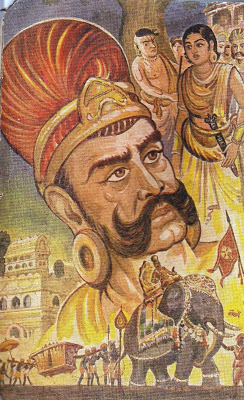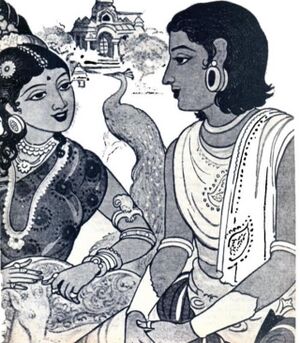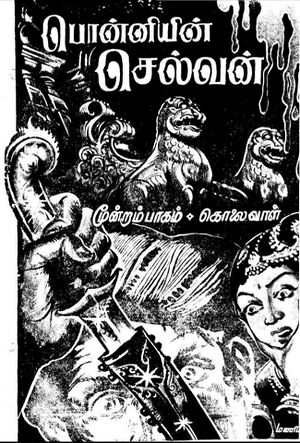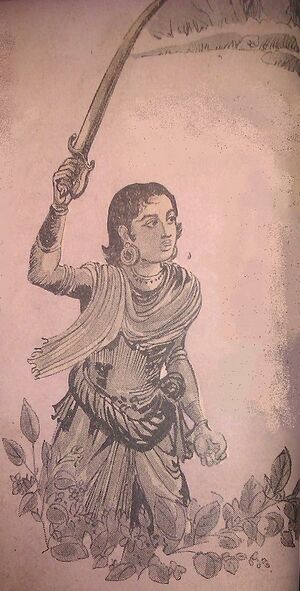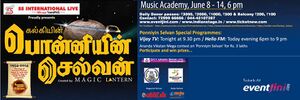Ponniyin Selvan (novel)
இந்தப் பக்கத்தை தமிழில் வாசிக்க: பொன்னியின் செல்வன் (நாவல்)
Ponniyin Selvan (1950-1955) is a five-part popular historical novel written by Kalki. The novel details Arulmozhivarman's (Raja Raja Chola) sacrifice of his Chola empire's throne. 'Ponniyin Selvan' is one of the titles bestowed on Raja Raja Chola. This novel is very popular in Tamil Nadu because it depicts the Chola period (The golden age of Tamil history) and for portraying its king Raja Raja Chola. Ponniyin Selvan novel is the top-selling popular fiction in the history of Tamil publication.
Creation, Publication
Ponniyin Selvan written by Kalki was serialized as a story in the Kalki weekly magazine from October 29, 1950 till 1955. Since then Ponniyin Selvan was re-published four times in the same Kalki magazine. It was published as a book on December 5, 1954 by Vanathi publications. After the novel was nationalized, it was printed by various publications. In the works written by Kalki, Sivagamiyin Sabatham preceded and Parthiban Kanavu anteceded Ponniyin Selvan.
Paintings
Paintings played a vital role in the success of Ponniyin Selvan. During the first publication Kalki's friend, Maniam (artist) painted for it. The aesthetics of Indian mural paintings were the inspiration for Maniam's paintings of Ponniyin Selvan. It was serialized five times along with paintings in the Kalki weekly magazine.
- Paintings of Maniam from 1950 till 1954.
- Paintings of Vinu from 1968 till 1972.
- Paintings of Maniam from 1978 till 1982.
- Paintings of Padmavasan from 1998 till 2002.
- Paintings of Veda from 2014.
Historical Background
Ponniyin Selvan was written by Kalki based mainly on books of K. A. Nilakanta Sastri's 'Cholas' and T. V. Sadasiva Pandarathar's 'Later Chola History'. The novel occurs between 957 to 973 AD, the final years of rule of Sundara Chola. He was born to Arinjaya Chola and Vaidumba princess Kalyani whose name is mentioned in Anbil inscriptions. Sundara Chola was called as Parantaka Chola II. The copperplate inscriptions of Leiden, Karandhai, and Thiruvalangadu indicate that in the Sevur battle, the Chola army led by Sundara Chola's son Aditya Karikalan defeated and killed the Pandiyan King Veerapandiyan. Aditya Karikalan received the name 'Veerapandiyan Thalaikonda' (Removed head of Veerapandiyan). Sri Lankan historical text 'Mahavamsam' notes that in this battle, Eelam king 4th Mahendrar helped the Pandyas. News of Aditya Karikalan's death is known from the Udaiyarkudi inscription.
The inscription, published in the second year of Raja Raja Chola's tenure, states that the Thiruveeranarayana Chaturvedimangala Sabha sentenced some chemists to death by the king for the crime of killing Aditya Karikalan. Madurantaka succeeded Sundara Chola and ruled for sixteen years under the name of Uttama Chola after his coronation. K.A. Nilakanta Sastri believes that Uthama Chola may have been responsible for the murder since the killers were not punished in those sixteen years. It is said in the Thiruvalankadu copperplate inscriptions that Raja Raja Chola, also known as Arulmozhivarman, voluntarily gave the throne to his younger father Uthama Chola. Ponniyin Selvan was fictionalized based on this information.
Novel Structure
Ponniyin Selvan has five parts.
- Pudhu Vellam (The First Floods)
- Suzhal Kaatru (Whirl Winds)
- Kolai Vaal (A Killing Sword)
- Mani Makudam (The Jewelled Crown)
- Thiyaga Sigaram (The Supreme Sacrifice)
Synopsis
Vallavaraiyan Vandiyadevan, a warrior of the Vanar clan, carries a haystack from the eldest son of Chola emperor Sundara Chola, Prince Aditya Karikala Chola of Kanchi to the Emperor of Tanjore Sundara Chola, and his daughter Princess Kundavai Pratiyar of Palaiyar. On the way, he finds a conspiracy in Kadambur Sambuvarayar's palace. They plan to crown Madurantaka Chola, the son of Sundara Chola's uncle Gandaraditya, as the emperor of the Chola Empire instead of Aditya Karikalan who was crowned as the Chola Prince. This ploy was conceived by Periya Pazhuvettaraiyar, emperor Sundara Chola's friend, and belonged to the clan of Pazhuvur who were commanders of the Chola army for centuries. Princes and generals from many clans were part of this.
This is the earlier history of the Chola dynasty. Gandaraditya, the second elder brother of Sundara Chola's father Arinjaya Chola, was a devotee of Lord Shiva. When Gandaraditya's elder brother, Rajaditya died in battle, Gandaraditya became entitled to the throne. Since he hated the consequences of war and did not wish to enthrone, Gandaraditya crowned his younger brother Arinjaya Chola who was well-versed in war tactics as the emperor. When Arinjaya Chola also died in battle in the next few years, as a general rule, Gandaraditya's son Madurantaka had the right to become the emperor. As Madurantaka was young and his parents Gandaraditya and Chembiyan Maadevi wished him to be a devotee of Lord Shiva, Arinjaya Chola's son Sundara Chola was crowned as the emperor.
Madurantaka grew up and against the aspirations of his parents wanted to capture the throne. Periya Pazhuvettaraiyar found this to be correct and exercised his powerful support for Madurantaka. Pazhuvoor's young Queen Nandini was the mastermind behind this plot and instigated the desire for the throne in the mind of Madurantaka. She was called the Queen by Pandyas as married the old Periya Pazhuvettaraiyar and made him a puppet dancing to her tunes. The bodyguards of Pandyas and its leader Ravidasan were supporting Nandini from behind. They aim to take revenge as Aditya Karikalan defeated and killed the Pandya king in a battle.
Vandiyadevan meets Kundavai and gains her love. He goes to Eelam, meets Aditya Karikalan's brother Arulmozhivarman and tells him about the conspiracy. Arulmozhivarman was shipwrecked while returning home, but he survived and rested at the Nagai Choodamani Vihara. On hearing the news and returning to Tanjore, Aditya Karikalan is mysteriously killed at the Kadambur Sambuvarayar Palace. The novel proceeds with the question of who killed Aditya Karikalan and the old love of Nandini and Aditya Karikalan. It tells the story of how Aditya Karikalan saw Nandhini as his wife in the cave where Pandyan was hiding and killed them in front of her eyes. ( திடீரென்று காணாமலான நந்தினியை பாண்டியன் ஒளிந்திருக்கும் குகையில் அவன் மனைவியாக கண்ட ஆதித்த கரிகாலன் அவள் கண்ணெதிரே பாண்டியனை கொன்றது ஆகிய செய்திகளைச் சொல்கிறது.)
Nandini's background and her relationship with Sundara Chola are described in the novel. The relationship between a young flower vendor named Senthan Amuthan and boat woman Poonkuzhali is detailed. The novel unties various knots to show that Madurantaka was not the biological son of Gandaraditya and his actual son was Senthan Amuthan.
Everyone wishes Arulmozhivarman to enthrone, as he untied knots of conspiracy, won against the enemies, and protected the country. But Arulmozhivarman sacrifices the throne to Senthan Amuthan who was the actual heir. Vandiyadevan marries Kundavai. Arulmozhivarman marries Vanathi. The novel ends by saying that Arulmozhivarman was later crowned Chola king by the name of Rajaraja Chola.
Characters
- Arulmozhivarman - Raja Raja Chola
- Vallavaraiyan Vandiyadevan - Raja Raja Chola's friend
- Kundavai - Arulmozhivarman's sister
- Nandini - Princess of Pazhuvoor, the young wife of Periya Pazhuvettraraiyar
- Aditya Karikalan - Raja Raja Chola's brother
- Vanathi - Princess of Kodumbalur, first wife of Raja Raja Chola
- Azhwarkadiyan - Spy, Vaishnavite, Aniruddha Brahmarayar's servant
- Mandakini - Also called 'Mute Queen' because of her inability to speak. Raja Raja Chola's Father Sundara Chola's lover
- Periya Pazhuvettaraiyar - Commander of Tanjore Fort. Held the most powerful position after the king
- Chembiyan Maadevi - Gandaraditya Chola's wife. Uthama Madurantaka Chola's mother
- Chinna Pazhuvettaraiyar - Periya Pazhuvettaraiyar's younger brother
- Aniruddha Brahmarayar - Sundara Chola's Prime Minister, later teacher of Raja Raja Chola
- Periya Vellalar Boothi Vikrama Kesari - Commander, King of Kodumbalur
- Poonkuzhali - The boat women, Uthama Madurantaka Chola's future wife
- Senthan Amuthan - Uthama Madurantaka Chola
- Duplicate Maduranthakar- Young man from Pandya kingdom, Amarabhujangan Nedunchezhiyan
- Ravidasan - One of the bodyguards (chief) from Pandya kingdom
- Kandhamaaran - Prince of Sambuvaraiyar family, Vandiyadevan's friend
- Manimegalai - Princess of Sambuvaraiyar family, Kandhamaaran's sister, she loved Vandiyadevan
- Parthibendran - Belonged to the Pallava dynasty, Aditya Karikalan's friend
Literary Influence
'The Three Musketeers' by Alexander Dumas has a great influence on Ponniyin Selvan. D'Artagnan's parallel in Vandhiyadevan and Milady de Winter in Nandini is strongly felt without any direct adaption or plagiarism. The author was able to construct the novel clearly in the historical and cultural context of the Cholas. Almost all the early historical novelists of Indian languages took the fictional structure from Alexander Duma, Lytton Prabhu, Pushkin, and Walter Scott.
Literary Significance
Ponniyin Selvan novel has a semblance to Mahabharata. In Mahabharata, Bhishma gave precedence to the hierarchy of caste over justice and virtue. Periya Paluvetrarayar has a similar vision and he is portrayed along the lines of Bhishma. Arulmozhuvarman has a comparable characteristic to Yudhishtra. ( Sivagamiyin Sabatham novel has some parallels to Ramayana) This historical semblance deeply establishes the novel in the Tamil Minds.
Ponniyin Selvan has a simple language and can be read at a very young age. It is devoid of negative qualities and creates elevations. Excess of lust and violence is absent, hence ensuring a pleasurable read experience till the end. Characters are realistically portrayed without dramatization as in adventure novels. Heroic deeds and battles are not exaggerated. The story often moves ahead with personal feelings and conspiracies at the palace. Ponniyin Selvan gains importance as it represented the period which is called the golden period of Tamil history. It has also depicted the youth of Raj Raja Chola, a chief personality at that time. In literature, it comes under the genre of historical fantasy.
Literary Extension
As a continuation to Ponniyin Selvan, many works revolving around Raja Raja Chola were written.
- Vikraman wrote the novel 'Nandhipurathu Nayagi'
- A drama called 'Raja Raja Cholan' was written by Aru. Ramanathan
- Balakumaran wrote a novel 'Udaiyar'
- Chandilyan's 'Mannan Magal' depicts the period of Rajendra Chola. Vandiyadevan is a character in that novel.
Translations
So far, Ponniyin Selvan has been translated to English by Indra Neelameggham, C. V. Karthik Narayanan, Pavithra Srinivasan, and Varalotti Rengasamy.
Other Forms
Illustrated Novel
- Ponniyin Selvan was published as an illustrated novel with 1200 color pictures in 2017 by Sixth Sense publications.
- Artist Thangam depicted the Ponniyin Selvan novel in 1050 paintings and published it in 10 parts.
Drama
- Kumaravel, Praveen from the Magic Lantern group dramatized the Ponniyin Selvan novel in 1999.
- TVK Cultural Academy produced and staged a drama based on Ponniyin Selvan novel in the 20s. Mallikraj was the director.
Movie
- Director Mani Ratnam has adapted the Ponniyin Selvan novel into a movie. The Screenplay has been written by Writer Jeyamohan.
Reference
- Biography of Writer Kalki
- Cholas, K. A. Nilakanta Sastri
Links
- Ponniyin Selvan's Illustrated version
- Ponniyin Selvan Podcast
- Ponniyin Selvan's comic form
- Ponniyin Selvan in drama form -
- Ponniyin Selvan - Book Review, giriblog
- Ponniyin Selvan's story brief in 4 minutes, Tamilnadu Now
- Ponniyin Selvan, full novel
- Ponniyin Selvan, Translator Pavithra Srinivasan's website
- Ponniyin Selvan, discussion forum
- Ponniyin Selvan, Part 1 in English, Amazon
- Ponniyin Selvan, Project Madurai
- Varalotti Rengasamy's English translation of Ponniyin Selvan
- Ponniyin Selvan, Nila comics
- Kalki an Era, Article
- Ponniyin Selvan, Paintings
